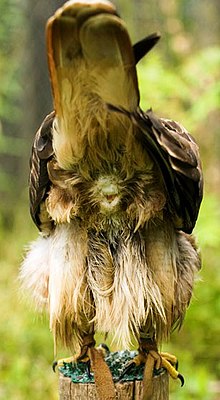
A cloaca (/kloʊˈeɪkə/ kloh-AY-kə), pl.: cloacae (/kloʊˈeɪsi/ kloh-AY-see or /kloʊˈeɪki/ kloh-AY-kee), or vent, is the rear orifice that serves as the only opening for the digestive, reproductive, and urinary tracts (if present) of many vertebrate animals. All amphibians, reptiles, birds, and a few mammals (monotremes, afrosoricids, and marsupial moles)[clarification needed] have this orifice, from which they excrete both urine and feces; this is in contrast to most placental mammals, which have two or three separate orifices for evacuation and reproduction. Excretory openings with analogous purpose in some invertebrates are also sometimes called cloacae. Mating through the cloaca is called cloacal copulation and cloacal kissing.
The cloacal region is also often associated with a secretory organ, the cloacal gland, which has been implicated in the scent-marking behavior of some reptiles,[1] marsupials,[2] amphibians, and monotremes.[3]
- ^ Carl Gans; David Crews (June 1992). Hormones, Brain, and Behavior. University of Chicago Press. ISBN 978-0-226-28124-7.
- ^ R. F. Ewer (11 December 2013). Ethology of Mammals. Springer. ISBN 978-1-4899-4656-0.
- ^ Harris, R. L., Cameron, E. Z., Davies, N. W., & Nicol, S. C. (2016). Chemical cues, hibernation and reproduction in female short-beaked echidnas (Tachyglossus aculeatus setosus): implications for sexual conflict. In Chemical Signals in Vertebrates 13 (pp. 145-166). Springer, Cham.